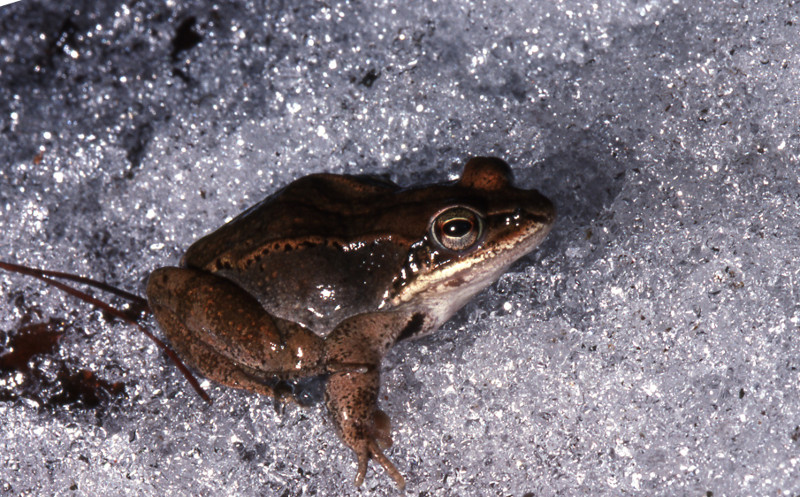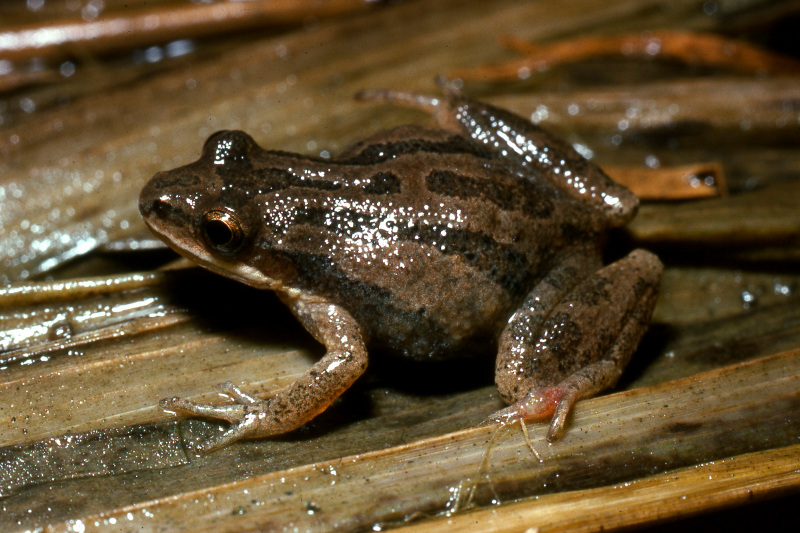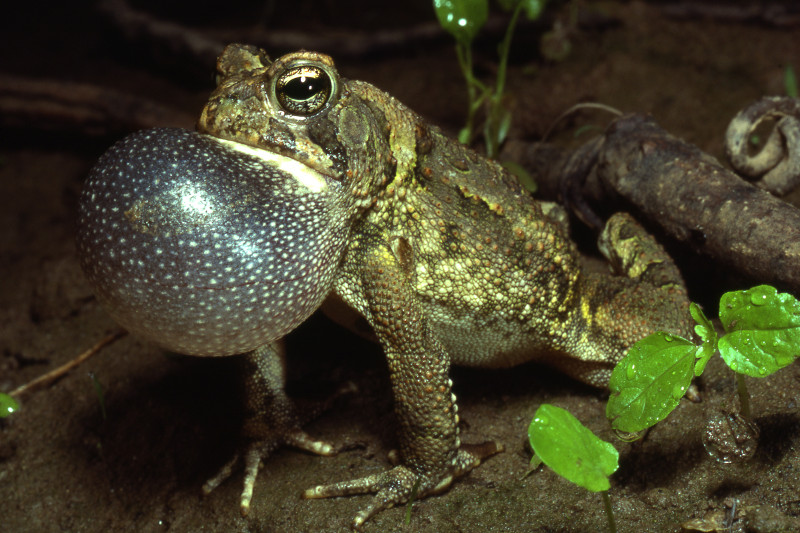 Vernal Pool Frogs and Toads
Vernal Pool Frogs and Toads
True Frogs (Ranidae)
Wood Frog (Lithobates sylvaticus) - INDICATOR
The wood frog is brown, reddish brown or copper colored with a white belly. A distinguishing feature
is a dark brown mask that stretches across its eyes. As an adult it reaches from 1 3/8 to 2 -
inches in length (Conant and Collins 1998). The wood frog is the most common vernal pool indicator
in Pennsylvania.
Wood frogs have a special adaptation for surviving the winter months. They stay in burrows or under leaf litter beneath the snow. When temperatures drop, they increase glucose production to high levels, which acts like an antifreeze that keeps them from freezing solid. This glucose antifreeze works down to a temperature of 20 degrees Fahrenheit (Hulse et al. 2001). Since the temperature at ground level rarely drops below that, they are protected from winter's cold.
Wood frogs spend most of the year in wooded upland habitats. They migrate to seasonal pools in the spring where they breed and lay their eggs. Males travel to the pools during the first rains of spring and begin calling to females with a distinctive quacking call. Their mating call has often been described as 'ducks in the woods'.- Their egg masses contain hundreds of eggs. Unlike the Jefferson and spotted salamander egg masses, wood frog egg masses are not enclosed in a firm matrix that helps the egg mass retain its shape. Wood frog egg masses are large, soft, and shapeless. Often wood frogs will deposit their eggs in communal nesting areas, creating large expansive egg masses. Like the salamander egg masses, wood frog egg masses often turn green from algae. The eggs develop for roughly 20 days, dependent upon temperature. Tadpoles are in the water for 80 to 115 days, emerging from the water in July and August (Hulse et al. 2001).
Bullfrog (Lithobates catesbeianus) - FACULTATIVE
This is our largest frog. Both males and females average
4 - inches in length (Hulse et al. 2001). They will consume whatever fits into their mouth, which has a
considerable gape. They are easily identified by their deep bass call. While somewhat similar in appearance
to the green frog, they are distinguishable by the complete lack of dorsolateral folds on the back. Male
and female bullfrogs can be identified by the size of the tympanum in relation to the eye. If the tympanum
is similar in size or larger than the eye, the frog is a male. If the tympanum is smaller than the eye, it
is a female. This sexing method also holds true for the green frogs.
Green Frog (Lithobates clamitans) - FACULTATIVE
The true frogs, which include the green frog, bullfrog,
leopard and pickerel frogs, have smooth skin with dorsolateral folds on their backs and long legs with webbed toes.
The green frog adult measures 2 to 3 inches in length. It is bright to dark green or brown on the dorsal surface,
but is most easily distinguished from similar species by the dorsolateral folds, or raised skin extending in a line
from the eye to the middle of the abdomen.
Pickerel Frog (Lithobates palustris) - FACULTATIVE
The average adult length of the pickerel frog is 2 1/8 to
2 inches; females are slightly larger than males (Hulse et al. 2001). This frog has two rows of rectangular
spots between the dorsolateral folds on the back and the yellow inner thighs. Both the pickerel and leopard
frogs have paired vocal sacs. All other Pennsylvania frogs and toads have a single sac under the chin. These
sacs are only visible when the frog is calling.
Northern Leopard Frog (Lithobates pipiens) - FACULTATIVE
Adults average 2 to 3' inches in length (Conant and Collins).
Dorsolateral folds run down the back all the way to the groin. Unlike the similar looking pickerel frog, the dorsal spots are rounded and are not in neat rows on the back. The inner thighs lack the yellow coloration found on the pickerel frog.
The northern leopard frog is similar in appearance to the southern leopard frog. The range where the frogs are found can also be used to separate the two species. The northern leopard frog occurs most frequently in the western third of the state and in portions of the Valley and Ridge Province. The southern leopard frog is found only in the extreme southeastern corner of the state (Hulse et al. 2001).
Tree and Chorus Frogs (Hylidae)
Gray Treefrog (Hyla versicolor/ chrysocelis complex) - FACULTATIVE
The skin on this tree frog is rather
rough and pebbly looking with a dark irregular blotch on the back. It is well camouflaged for a summer spent
foraging in the trees. This photo shows how well they blend in with their surroundings. Average length is 1
to almost 2 inches (Hulse et al. 2001). Another identifying mark on this amphibian is the bright dandelion-colored
yellow skin on the inside of its legs. The gray treefrog has particularly large toepads, which allow it to move
about in trees with ease.
There are two species of gray treefrogs in Pennsylvania: Hyla versicolor and H. chrysocelis. The two species are difficult to separate based on visual appearances. Their calls can be used to identify them. H. versicolor is a common species found statewide. H. chrysocelis may be a rare find in Pennsylvania; Hulse et al. (2001) reports the potential for H. chrysocelis in southwestern Pennsylvania.
Spring Peeper (Pseudacris crucifer) - FACULTATIVE
The key identifying feature of this small tree frog is the 'X' on its back. Adults are approximately 1 to 1 - inches in length (Hulse et al. 2001). Like all the tree frogs,
they have toe discs that allow them to live in the trees after the breeding season is over.
Calling spring peepers are often heard but seldom seen. Males call to establish a territory and to attract a mate. The inflated vocal sac is filled with air and acts as a resonating chamber to amplify the sound they make.
The eggs of Pennsylvania's frogs and toads are fertilized externally. The male grasps the female from behind (amplexus) and as she drops her eggs into the water, he fertilizes them.
FACULTATIVE
Chorus frogs
are small tree frogs measuring slightly more than an inch in length (Hulse et al. 2001).
These frogs are identified by the presence of three dorsal longitudinal stripes.
Three species of striped chorus frog are found in Pennsylvania: Pseudacris triseriata, the western chorus frog; P. feriarum, the upland chorus frog; and P. kalmi, the New Jersey or coastal plain chorus frog. They are probably easiest to separate based on geographical range. The western chorus frog is found in the westernmost tier of counties and has three broad longitudinal stripes. The upland chorus frog occurs primarily in the mid and southcentral counties of the state; it has three thin stripes that are often broken. The New Jersey chorus frog is found only on the coastal plain in the southeastern part of the state. It typically shows three broad stripes, and has a more robust build than the other two species (Hulse et al. 2001).
Southern Leopard Frog (Lithobates spenocephalus) - FACULTATIVE
This frog is known only from the southeastern
part of the state. It is very similar in size and appearance to the northern leopard frog but can be distinguished
by the presence of a light spot on the center of the tympanum.
Spadefoots (Pelobatidae)
Eastern Spadefoot (Scaphiopus holbrookii holbrookii) - INDICATOR
The eastern spadefoot is a rarely encountered toad-like frog. It is often called a toad because
it resembles one, but it is actually a primitive species of frog that spends most of its life
underground feeding on insect larvae and adults (Hulse et al. 2001). They are small, measuring
1 to 2 inches in length (Conant and Collins 1998). They have strong legs and webbed hind
feet, equipped with a hard, sharp projection used as a digging 'spade.-
Spadefoots emerge to breed after intense rainfall such as heavy thunderstorms in the spring or summer. When conditions are right, all the spadefoots in a local area may emerge, move to seasonal pools, breed, lay eggs, and return underground within a few days. Because it is dependent on sudden bursts of heavy rainfall, development in the spadefoot is accelerated compared to other seasonal pool species. Eggs can hatch in only 24 hours, and larvae metamorphose into adults in 28 to 63 days (in Hulse et al. 2001).
There is much to be learned about the eastern spadefoot. Their breeding activity is unpredictable because it depends on the frequency and intensity of rainfall, which can vary greatly from year to year. Eastern spadefoots are not strictly tied to spring breeding, as are many other seasonal pool species. They have been found breeding in Pennsylvania from April through August (Hulse et al. 2001). Additionally, they will commonly breed in small rain-filled pools in agricultural fields or floodplains'habitats even more ephemeral than the average seasonal pool.
This species of frog has been found in the Cumberland and Susquehanna Valleys of Pennsylvania, from the Maryland border north to Northumberland County (Hulse et al. 2001). Spadefoots prefer soft and/or sandy soils for digging their burrows.
True Toads (Bufonidae)
American Toad (Anaxyrus americanus) - FACULTATIVE
This is the common hop toad found in many backyards across the
state. It averages 2 to 3 inches in length (Conant and Collins 1998). American toads exhibit a sexual dimorphism;
males are smaller than females. The paratoid glands found on the back of the head can secrete a toxin to discourage predators.
American toad eggs are easy to identify because they are laid in long spiral strings, not singly or in clumps.
Fowler's Toad (Anaxyrus woodhousii) - FACULTATIVE
This toad is similar in size to the American toad, and is
2 to 4 inches in length (Conant and Collins 1998). Fowler's toad usually has three or more large warts on each
large dark spot on its back while the American toad has only one or two large warts. The American toad has spots
on the chest and belly while Fowler's toad has an unmarked ventral surface.























 adj.jpg)











